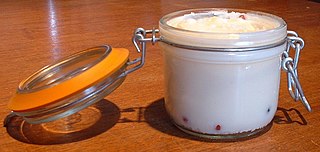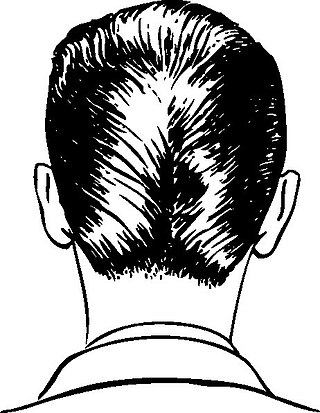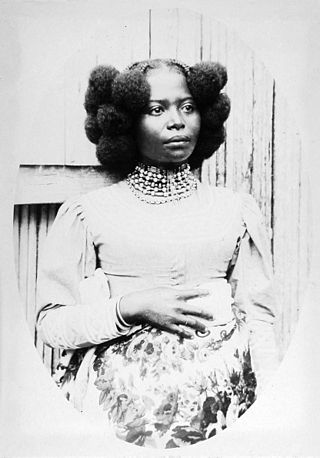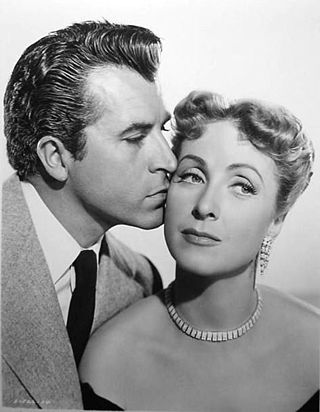
Beeswax is a natural wax produced by honey bees of the genus Apis. The wax is formed into scales by eight wax-producing glands in the abdominal segments of worker bees, which discard it in or at the hive. The hive workers collect and use it to form cells for honey storage and larval and pupal protection within the beehive. Chemically, beeswax consists mainly of esters of fatty acids and various long-chain alcohols.

Tallow is a rendered form of beef or mutton suet, primarily made up of triglycerides.

Petroleum jelly, petrolatum, white petrolatum, soft paraffin, or multi-hydrocarbon, CAS number 8009-03-8, is a semi-solid mixture of hydrocarbons, originally promoted as a topical ointment for its healing properties. Vaseline has been an American brand of petroleum jelly since 1870.

Brylcreem is a British brand of hair styling products for men. The first Brylcreem product was a hair cream created in 1928 by County Chemicals at the Chemico Works in Bradford Street, Birmingham, England, and is the flagship product of the brand. The cream is an emulsion of water and mineral oil stabilised with beeswax. It is notable for the high shine it provides, which spawned the name of the product, stemming from "brilliantine" and "cream".

Hair wax is a thick hairstyling product containing wax, used to assist with holding the hair. In contrast with hair gel, most of which contain alcohol, hair wax remains pliable and has less chance of drying out. It is often sold under names such as pomade, putty, glue, whip, molding gum, or styling paste. The texture, consistency, and purpose of these products varies widely and each has a different purported purpose depending on the manufacturer. Traditionally, pomade is a type of hair wax that also adds shine to one's hair.

Hair conditioner is a hair care cosmetic product used to improve the feel, texture, appearance and manageability of hair. Its main purpose is to reduce friction between strands of hair to allow smoother brushing or combing, which might otherwise cause damage to the scalp. Various other benefits are often advertised, such as hair repair, strengthening, or a reduction in split ends.

Hair gel is a hairstyling product that is used to harden hair into a particular hairstyle.

The ducktail is a men's haircut style popular during the 1950s. It is also called the duck's tail, duck's ass, duck's arse, or simply D.A. and is also described as slicked back hair. The hair is pomaded (greased), combed back around the sides, and parted centrally down the back of the head.

Moustache wax is a stiff pomade applied to a moustache as a grooming aid to hold the hairs in place, especially at the extremities. The required product strength is based on whisker length and the desired style. It can also have restorative properties, which become more important as the hair length increases. The wax is usually scented and sometimes pigmented with dyes; high end products utilize various combinations of iron oxide to create darker shades.

Cold cream is an emulsion of water and certain fats, usually including beeswax and various scent agents, designed to smooth skin and remove makeup. Cold cream is a water-in-oil emulsion, unlike the oil in water emulsion of vanishing cream, so-called because it seems to disappear when applied on skin. The name "cold cream" derives from the cooling feeling that the cream leaves on the skin. Variations of the product have been used for nearly 2000 years.

The conk was a hairstyle popular among African-American men from the 1920s up to the early-to-mid 1960s. This hairstyle called for a man with naturally "kinky" hair to have it chemically straightened using a relaxer called congolene, an initially homemade hair straightener gel made from the extremely corrosive chemical lye which was often mixed with eggs and potatoes. The applier had to wear gloves and the solution timed just right on the applicant's head and then thoroughly rinsed out with cold water to avoid chemical burns. The desired outcome was for the newly straightened hair to be easily styled in the popular "conk" style of that era.

The pouf or pouffe also "toque" is a hairstyle and a hairstyling support deriving from 18th-century France. It was made popular by the Queen of France, Marie Antoinette (1755–1793), when she wore it in June 1775 at the coronation of her husband Louis XVI, triggering a wave of French noblewomen to wear their hair in the same manner. The hairstyle would become popular across Europe in the 1770s.

Kinky hair, also known as afro-textured hair, is a human hair texture prevalent in the indigenous populations of many regions with hot climates, mainly sub-Saharan Africa, Melanesia, and Australia. Each strand of this hair type grows in a repeating pattern of small contiguous kinks. These numerous kinks make kinky hair appear denser than straight, wavy, and curly hair types.
Personal care products are consumer products which are applied on various external parts of the body such as skin, hair, nails, lips, external genital and anal areas, as well as teeth and mucous membrane of the oral cavity, in order to make them clean, protect them from harmful germs and keep them in good condition. They promote personal hygiene and overall health, well-being and appearance of those body parts. Toiletries form a narrower category of personal care products which are used for basic hygiene and cleanliness as a part of a daily routine. Cosmetic products, in contrast, are used for personal grooming and beautification. Pharmaceutical products are not considered personal care products.
Hairstyle products are used to change the texture and/or shape of hair.

In the Western world, the 1950s were a decade known for experimentation with new styles and culture. Following World War II and the austerity years of the post-war period, the 1950s were a time of comparative prosperity, which influenced fashion and the concept of glamour. Hairstylists invented new hairstyles for wealthy patrons. Influential hairstylists of the period include Sydney Guilaroff, Alexandre of Paris and Raymond Bessone, who took French hair fashion to Hollywood, New York and London, popularising the pickle cut, the pixie cut and bouffant hairstyles.
Greasy hair is a hair condition which is common in humans, one of four main types of hair conditioning— normal, greasy, dry and greasy dry. It is primarily caused by build-up of the natural secretion from the sebaceous glands in the scalp and is characterised by the continuous development of natural grease on the scalp. A chronic condition of greasy hair may often accompany chronic greasy skin conditions on the face and body and oily skin and acne. Excessive carbohydrate, fat and starch consumption can increase the likelihood of developing greasy hair and also poor personal hygiene and not washing the hair for a long duration will lead to a buildup of sebum in the hair follicles. Hair conditioners can decrease the likelihood of developing greasy hair after shampooing. Some cosmetics companies produce shampoos and conditioners specifically to deal with greasy hair and for oily or dry hair problems. Massaging the scalp and exposure to the sun can reduce the problem of greasy hair.

Frizz is hair that does not align with the surrounding hair, but stands up or curls independently, creating a fuzzy or irregular texture. The three main causes of frizz are genetics, hair damage, and humidity. Frizzy hair can be seen as a positive or a negative trait depending on the current fashion and one's personal preference. Many hair products, such as gels, pomades, and hair waxes, are designed to reduce frizz.

Hair oil is an oil-based cosmetic product intended to improve the condition of hair. Various types of oils may be included in hair oil products. These often purport to aid with hair growth, dryness, or damage.


















